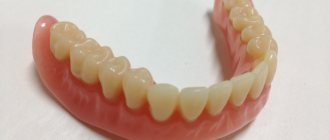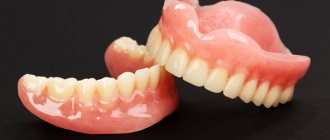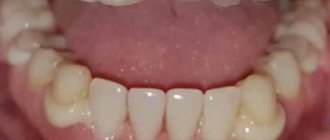Complete edentia is characterized by the absence of all teeth - in one or both rows. The solution to the problem can be removable prosthetics or implantation. The second method is more comfortable, aesthetically pleasing and durable in the long term. However, removable dentures also cannot be discounted - with complete edentia, this is the most economical option for prosthetics. In addition, this is the only solution for patients with contraindications to surgery.
With complete edentia, removable dentures are fixed mainly on the gums. They “stick” to the soft mucous membranes and adhere tightly to them. It is due to this that the structure is retained in the mouth. Towards the end of its service life, the structure will stretch a little and will be held less reliably - special dental glue will solve the problem.
Possibilities of removable dentures in the absence of all teeth
If there are no teeth left, the patient may be offered the choice of the following removable dentures:
- plate acrylic dentures : the most inexpensive option, which is created from hard plastic. Such structures adhere rather poorly to the gums, they are massive and often rub the mucous membranes. But the Smile-at-Once clinic uses new generation acrylic with the addition of diamond chips. Such dentures are distinguished by good aesthetics, a tight fit to the gums and increased wear resistance.
- prostheses made of elastic plastics : this category includes structures made from soft and elastic plastics. They fit snugly to the gums, are securely held in the mouth and have a fairly natural appearance. This category includes nylon and Acry Free (Acry Free)
- A separate category for almost complete loss of teeth also consists of removable dentures with locks. But to fix them, at least two living tooth roots are required on which such a prosthesis will be attached.
- nylon prostheses not used at the Smile-at-Once clinic . Just over 10 years ago, they were a real revolution in the field of removable prosthetics - compared to plate ones, they were more comfortable. However, in practice it has been proven that such dentures, due to the increased elasticity of the material, stretch greatly after 1-2 years, which means they do not adhere well to the gums (especially on the lower jaw), require frequent adjustments (relining) and cause pain while eating . In addition, due to elasticity and uneven pressure, they lead to acute bone atrophy and reduction in the volume of the alveolar ridge.
- removable dentures on implants are the best and most comfortable option for removable dentures; they do not pop out on the lower jaw and do not have a palate, like previous options for replacing teeth on the upper jaw, which blocks the taste buds and can cause a gag reflex. They are securely fixed in the oral cavity due to the presence of a support at least 4 points and a beam connecting the implants, onto which they snap. Their disadvantage is the cost, which today is almost equal to alternative solutions for fixed prosthetics on implants, for example All on 4 or All on 6 with screw fastening.
When is a removable partial denture placed?
Based on the name, you can understand that a partial removable dental prosthesis imitates a fragment of the dentition. This design can replace several missing teeth in a row or teeth lost in different areas of the jaw. Depending on this factor, the shape and size of the structure itself changes. In general, all types of removable dentures are united by a number of solutions. The base of a partial removable denture imitates soft tissues and part of the palate (if installed on the upper jaw). The boundaries of the prosthesis are clearly defined, since otherwise it would rest on the inner part of the base of the lips and would be unsuitable for wear. Artificial teeth made of plastic are installed in the base, which replace the crown part of missing natural teeth. In general, the design is quite simple, but this is precisely what makes this product so popular and widespread. There are a variety of materials used to make partial dentures, but some of them (for example, plastic) can cause allergic reactions.
Stages
1 Consultation, diagnostics
2 Preparation
3 Surgery
4 Orthopedics
The doctor will visually examine your teeth and gums to make an initial assessment of their health. He will collect anamnesis, conduct a hardware examination (orthopantomogram + computed tomography), and make sure that there are no contraindications to prosthetics on implants.
Plaque and stone are removed, diseased teeth on the antagonist jaw (if there are teeth) are treated. The implant dentist prepares a treatment plan, incl. 3D model of the jaw for detailed planning of the operation. A date for the operation is set and a contract is concluded.
An injection of local anesthesia is administered. Four or six implants are installed depending on the technology used for prosthetics of a toothless jaw.
On days 3-7 after installation of the implants, a temporary (adaptation) prosthesis is fixed on them. At the end of the period of osseointegration of the artificial roots, a permanent prosthesis is placed.
Types of partial dentures
Despite the fact that most removable dentures are very similar, experts divide them into several types. The main parameters are the number of teeth to be replaced and the material of manufacture.
Butterfly prosthesis
So named because of its shape, which resembles the wings of a butterfly. In most cases, a butterfly denture is installed when 1–2 teeth are missing in a row.
Partial removable clasp denture
A design that has an all-metal frame. Due to the metal arch, the clasp denture looks compact, but is less aesthetically pleasing than metal-free structures. In addition, metal can cause an allergic reaction.
Partial removable laminar denture
A removable lamellar prosthesis does not contain metal parts (fastening elements can be made of metal) and, in comparison with clasp structures, has a wider soft base.
Partial removable plastic denture
It is the cheapest design, which is often used as a temporary measure (for example, after implantation). A prosthesis made of acrylic plastic has the necessary rigidity, but is less comfortable than softer systems and can cause allergies.
Removable nylon partial dentures
Modern, comfortable and soft nylon prostheses, which, however, are significantly more expensive than plastic structures.
Advantages and disadvantages
Advantages
- Restoring the aesthetics and functioning of the dentition;
- used in complex clinical situations when reconstruction methods are impossible;
- selection of types of orthopedic products;
- installation without preliminary grinding of abutment teeth;
- variability of materials for manufacturing;
- without restrictions;
- speed of production and installation;
- repair of the orthopedic system in case of mechanical damage;
- ease of wearing and care;
- exceptional hygiene and safety;
- no age restrictions;
- use as a temporary prosthetic structure;
- service life (5-8 years);
- preservation of aesthetic indicators;
- price.
Flaws
- Restoration of chewing function is not complete;
- changes in diction, taste sensitivity during the period of adaptation;
- the likelihood of gum inflammation, irritation of the oral mucosa;
- uneven distribution of chewing loads;
- unable to stop or prevent jawbone atrophy;
- not all types of dentures and fixtures can be repaired;
- risk of damage to tooth enamel, development of cervical caries in the area where the attachments adhere to the supporting ones;
- relatively long period of adaptation;
- deformation and subsidence of the product (for metal-free structures);
- insufficient fastening on the lower jaw (applies to complete removable dentures).
Partial removable denture for the upper and lower jaw
If we compare partial and complete removable dentures, then complete structures for the upper and lower jaws have very noticeable differences. For example, in the absence of all the teeth in the lower jaw, the prosthesis, in fact, rests only on the alveolar processes, which cannot be called a reliable fixation. Partial dentures are placed on natural teeth, so there are fewer problems with attachment. The upper partial denture has an artificial palate, which provides additional stability. However, thanks to clasps or attachments, the prosthesis is also very stable.
Why is prosthetics necessary?
You should not treat missing teeth negligently. The consequences will require serious intervention. The absence of units poses problems:
- The remaining teeth shift and the bite changes.
- The gums atrophy and bone mass decreases.
- Chewing food becomes poor quality: problems with the gastrointestinal tract arise.
Due to an increase in the load on existing teeth and inadequate redistribution, destructive changes in the jaw joints begin.
Manufacturing of removable dentures
Prosthetics with various types of dentures has been used in clinical practice for decades, so dentistry has a well-functioning production mechanism.
Stages of manufacturing a partial removable denture
- Initial consultation, examination of the oral cavity and selection of orthopedic design.
- Taking impressions and producing a wax model in the laboratory.
- Grinding and correction of the finished structure.
- Finishing the structure in the articulator and trying on the wax structure by the patient.
Although the production of a partial denture takes on average 2 weeks, the adjustment period can last up to a month. At this time, the patient may feel some discomfort, but if the prosthesis causes significant pain and discomfort, it is worth contacting a specialist for correction or replacement of the structure.
Types of prosthetics for complete absence of teeth
In dental orthopedics, there are two options for complex prosthetics for total edentia: removable and fixed.
Fixed prosthetics
The Family Dentistry clinic performs daily rehabilitation operations for patients with complete absence of upper or lower teeth. We have performed more than 1,200 total jaw replacements.
All-on-4
A protocol for complex prosthetics, involving the installation of a fixed prosthesis with 10 or 12 crowns supported by four implants:
- two are implanted in parallel in the anterior section;
- two at an angle of up to 45° in the distal.
Why is inclined implantation of two implants used? Firstly, to increase the contact area between the bone and the implant (allows you to abandon the sinus lift). Secondly, in order to eliminate the risk of damage to the mandibular nerve or maxillary sinuses.
All-on-4 technology or “All-on-4” is a predictable and well-studied method of treating complete edentia (used since 1998) without bone grafting with good results in the short, medium and long term.
3-4 hours after installation of the implants or 3-7 days (often you need to wait for the swelling of the mucous membrane to go away after surgery), a temporary prosthesis is attached to the abutments.
After complete engraftment of titanium screws into the bone tissue (on average, this takes from 3 to 6 months), fixation is carried out with a permanent orthopedic structure.
All-on-6
A technique for complete jaw prosthetics for total edentia, developed on the basis of the All-on-4 protocol and being its logical, modified continuation.
To make it possible to use the technology in the rehabilitation of patients with a complex clinical picture (severe bone tissue atrophy, periodontitis/periodontal disease, diabetes mellitus, osteoporosis), six implants are used:
- two are fixed in the frontal zone;
- four – in the distal lateral section (two each on the right and left).
The use of a larger number of implants provides more reliable support for a fixed prosthesis (a bridge structure with a length of 14 crowns can be installed) and uniform distribution of the chewing load throughout the entire arch.
Fixation and stabilization of partial dentures
Methods for fixing partial removable dentures have remained unchanged over the past 10 to 20 years, i.e., since the advent of modern plate dentures.
| Fixation method | Description |
| Clasps | Metal or silicone hooks that fit around natural teeth and secure the denture in the mouth. |
| Attachmen | Micro-locks are installed on the supporting teeth, which snap into place upon contact with the structure. |
| Telescopic crowns | They are considered a very complex structure. The natural tooth is prepared and a special metal cap is put on it, after which a clasp prosthesis with grooves for fastening is installed. |
Questions and answers
Are there any contraindications to fixed prosthetics supported by implants?
Absolute contraindications include:
- chronic heart failure, angina pectoris, arterial hypertension;
- diseases of the blood and hematopoietic system;
- oncology (cancer, sarcoma);
- pathologies of the immune system.
Relative contraindications in which surgery is postponed include:
- poor oral health;
- presence of dental diseases (gingivitis, pulpitis, periodontitis);
- malocclusion;
- diseases of the temporomandibular joint, etc.
What material do you use to install a permanent fixed prosthesis?
For total prosthetics of an edentulous upper or lower jaw supported by implants, we install a permanent bridge with crowns made of zirconium dioxide - the most durable and aesthetic material in modern dental orthopedics.
How to care for a fixed overdenture on implants?
- Be sure to purchase a new toothbrush with a soft or ultra soft hardness level. Start brushing her new teeth only after three days from the date of surgery. It is better to use a herbal paste to prevent gum inflammation.
- To clean the interdental spaces and the space between the denture and the gum (a toothbrush cannot get there), use an irrigator, but only from the 3rd week after installation of the implants. You should start with the initial speed, gradually increasing it.
- Use a mouthwash after every meal. They fight bacteria in the mouth and freshen breath.
- Visit your dentist once every six months for a preventive examination and professional oral hygiene (cleaning your teeth from plaque and tartar).
Is complete prosthetics of the upper jaw different from the treatment of an edentulous lower jaw?
The peculiarity of the upper jaw is that it receives less chewing load and is therefore inferior in density to the lower jaw. Its structure is looser and more susceptible to resorption. For her rehabilitation, the “All-on-six” method is indicated. A larger number of supports is necessary to ensure reliable fixation of the complete bridge.
For the treatment of total adentia of the lower jaw, in most clinical cases, the “All-on-4” concept is optimal, since four are quite enough to support the orthopedic structure.
It is important to know that dental implants take root faster in the lower jaw - in 2-3 months. On the top it is slower - in 5-6 months.
Pros and cons of partial dentures
Partial dentures have a number of pros and cons. This is an ideal option for temporary prosthetics. However, if implantation is possible, you definitely do not need a removable denture. In any case, it doesn't hurt to know which partial dentures are best. Elastic (but not too soft) designs made from hypoallergenic materials are considered to be of the highest quality. In case of partial absence of teeth, removable laminar dentures made of nylon and acrylic-free plastic are the optimal solution.
- Low price.
- Acceptable functionality and aesthetics.
- Fast production.
- Easy hygiene.
- They do not load the bone, which is why the bone tissue decreases.
- Fragility and fragility (the circuit prosthesis lasts a maximum of 5 years).
- Difficulty getting used to it.
Immediate dentures
Removable immediate dentures - to replace defects in the dentition during the production of a permanent orthopedic system. There are three types of such models - full, partial, butterfly.
They cope with the task, return partial work to a lost dental unit and hide a visual defect. The disadvantages include fragility, fragility, and long addiction.
How much do partial dentures cost?
The cost of partial dentures depends on several factors, the main ones being the number of teeth being restored and the material used.
| View | Price |
| Butterfly prosthesis | From 3,000 rubles |
| Plastic partial denture | From 7,000 rubles |
| Clasp prosthesis | From 25,000 rubles (with clasps) From 35,000 rubles (with attachments) From 80,000 rubles (with telescopic crowns) |
| Nylon prosthesis “Quadrotti” | From 37,000 rubles |
| Prosthesis "Acry Free" | From 35,000 rubles |
How to quickly get used to a removable prosthetic system?
After installing a denture, it will take time to get used to it. To ensure that adaptation proceeds without problems, we recommend:
- Do not remove from mouth for long;
- suck on lollipops to suppress the feeling of nausea;
- read aloud to practice clear diction;
- For the first few days, follow a gentle diet.
Addiction lasts on average 2-4 weeks. If discomfort persists for more than a month, pain intensifies, gums become inflamed and bleed, you should consult a doctor.
What problems can be avoided?
Let's consider what problems can be solved when using prosthetics with a removable orthopedic design:
- the aesthetics of the smile is restored,
- the gums in the area of the row defect (missing tooth) are protected from injury by hard pieces of food,
- bite relationships and occlusion are preserved: therefore, the antagonist (opposite from above or below) does not move down or up,
- neighboring teeth are not so overloaded during chewing,
- The teeth adjacent to the defect do not move: if you leave a “gap” in the row and do not perform prosthetics, then the “neighbors” on the right and left will gradually shift towards it. Thus, in the future it will be difficult to install a prosthesis or even have to wear a brace system.
Implantation of artificial teeth
A modern, long-lasting option for the restoration of front teeth is implantation. This operation involves inserting a special pin into the jaw bone, in the place where a tooth is missing, which will act as a tooth root and will counteract atrophic changes in bone tissue. This pin is made of titanium and does not cause any inconvenience or complications in the future. Then a crown made of ceramic is installed on this titanium rod. Implantation makes it possible not to touch the healthy teeth in the neighborhood. For this procedure, high-quality durable implants from the Nobel Biocare brand are used, which are guaranteed for life. The implanted tooth will not differ in any way from the rest, since the crown is made after measurement and exactly matches the shape and natural shade of the teeth. Another technique for using dentures on the front teeth is installing a bridge.
The name “bridge” was borrowed from technicians, since its installation uses the principle of constructing bridges. A bridge is a type of permanent dental prosthesis; they are used to replace defects of several teeth (up to four) in a row. To do this, special crowns are installed on the adjacent good teeth, between which the prosthesis will be placed. The negative quality of this technique is the need to grind down the surface and remove the pulp of healthy teeth on which crowns will be placed. The bridge also needs to be replaced at least once every few years. But with these disadvantages, this method allows you to avoid surgical intervention.
Types of edentia
Adentia is the absence of teeth in the oral cavity. There are several types:
- Primary: when the patient initially did not have a permanent or baby tooth germ.
- Secondary: the tooth erupted, but after some time was removed (due to injury or caries and its complications).
Also distinguished:
- complete edentia: all teeth in the mouth are missing;
- partial (incomplete): one or more were removed.
Treatment and dental prosthetics are carried out only after diagnosis. It is important for the doctor to assess the condition of the gums and bone tissue. The treatment and prosthetic plan will depend on this.
Cost of dental restoration
How much does a denture cost for one tooth? In Moscow and the regions, the price of an immediate prosthesis averages 6000-7000 rubles, and a splinting clasp prosthesis costs from 60 thousand rubles. Also, before prosthetics, it is necessary to undergo the removal of tartar and plaque, treatment of existing caries, pulpitis, stomatitis - all these procedures are paid separately.
[1] Abolmasov N.G. Orthopedic dentistry, 2002.
Author: Sambuev B. S. (Thank you for your help in writing the article and the information provided)
Prosthetics of anterior teeth using crowns
Sometimes lesions on the front teeth can be more serious. Then prosthetics of the front teeth using crowns is suitable. To make the most natural shape of the tooth being installed and to ensure a tight fit of the crown, it is necessary to grind the affected tooth and, if necessary, remove the pulp and nerve. Then process and seal the canals. After fitting, a ceramic crown is installed on the dental cement mortar. Ceramic or zirconium structures without metal are best suited for dental prosthetics.
The main advantages of such crowns are:
- The base from which the dentures are made must be hypoallergenic. Which is very important. Ceramic crowns do not cause allergic reactions.
- Ceramic crowns look aesthetically pleasing. Based on individual measurements and subsequent fitting, you can ideally select the desired shape and color that will match the natural shade of natural teeth.
- Metal-free crowns do not cause darkening of the gums around the installed tooth and do not leave a metal rim. They also do not lead to alveolitis, gingivitis and periodontitis.
- Ceramic crowns will not cause discomfort when eating food at different temperatures.
- Also, such crowns are lightweight, comfortable and durable.
Which option to choose among removable ones?
Which prosthesis[1] should I put on one tooth? It is recommended to select the best option individually, together with an orthopedic dentist. If the speed of prosthetics is important, and the supporting teeth do not have pathological mobility, then it is better to choose a “butterfly” made of acrylic or “Acry-free” for the chewing part of the row. Nylon, of course, is comfortable, but for a very short time, and a stretched product will have to be changed soon. In the presence of pathological mobility, only the splinting clasp remains.
But do not forget that all the options considered are recommended for temporary use only. They are not very securely fixed (especially in the “smile zone”, where the supporting crowns are not so wide) and do not stop bone tissue atrophy. Therefore, it is better to turn to alternatives.
“I wore a bow tie during pregnancy until I could get an implant. It’s not very convenient, and you have to constantly clean it. But I was afraid that without a prosthesis, neighbors would move towards each other, and I would generally suffer later. I was afraid that it would fall out while eating and I would swallow it. Therefore, I had to chew very carefully.”
Olga R., review from baby.ru
Work examples:
All works
Restoration of both jaws with removable acrylic dentures
Conditionally removable prosthesis using a fastening system on Rhein-83 attachments
All works
Sign up for a consultation
three ROOTT specialists + diagnostics as a gift
Caring for dentures
They are not difficult to care for. All that is needed:
- Clean morning and evening with a soft brush and pastes that do not contain abrasives;
- rinse your mouth every time after eating;
- regularly treat with an antiseptic;
- give up sticky (chewing gum, toffee), excessively hard foods (nuts);
- Once every six months, take the denture to an orthopedist for cleaning and correction.
Compliance with these simple rules extends the service life and preserves the original appearance of dentures.
Article Expert
Alekperov Roman Borisovich Dentist-orthopedist, doctor of the highest category
Work experience: more than 31 years











